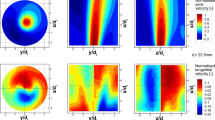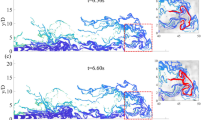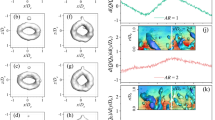Abstract
This study investigates self-sustained oscillation of the flow in a double-cavity channel with cavity length–width ratio L/H = 3 using a time-resolved particle image velocimetry (TR-PIV) technique. Three Reynolds numbers based on the cavity length L and the bulk velocity in the narrow section of the channel \(U_{0}\), i.e., \(Re_{L}\) = 12,500, 24,580, and 49,100, are considered to investigate the influence of Reynolds number on the self-sustained oscillation. As the Reynolds number increases, the oscillation becomes more intense and shifts to the leading edge of the double-cavity channel. However, the power spectra and contour plots of the spatial v–v correlation coefficient reveal that the periodicity of the oscillation becomes less profound as the Reynolds number increases. A further phase-averaged analysis reveals the spatiotemporal evolution process of oscillation and convincingly demonstrates a more intense and complicated process of the oscillation as the Reynolds number increases.
Graphic abstract













Similar content being viewed by others
References
Basley J (2012) An experimental investigation on waves and coherent structures in a three-dimensional open cavity flow. Doctoral Thesis
Basley J, Pastur LR, Lusseyran F, Faure TM, Delprat N (2011) Experimental investigation of global structures in an incompressible cavity flow using time-resolved PIV. Exp Fluids 50:905–918
Bilanin AJ, Covert E (1973) Estimation of possible excitation frequencies for shallow rectangular cavities. AIAA J 11:347–351. https://doi.org/10.2514/3.6747
Cherdron W, Durst F, Whitelaw JH (1978) Asymmetric flows and instabilities in symmetric ducts with sudden expansions. J Fluid Mech 84:13–31
Drikakis D (1997) Bifurcation phenomena in incompressible sudden expansion flows. Phys Fluids 9:76–87. https://doi.org/10.1063/1.869174
Durst F, Melling A, Whitelaw JH (2006) Low Reynolds number over a plane symmetric sudden expansion. J Fluid Mech 64:111–128
Fearn RM, Mullin T, Cliffe KA (2006) Nonlinear flow phenomena in a symmetric sudden expansion. J Fluid Mech 211:595–608
Froelich A, Immich H, Lebail F, Popp M, Scheuerer G (2006) Three-dimensional flow analysis in a rocket engine coolant channel of high depth/width ratio. In: Joint propulsion conference
Gerlach CR (1971) Vortex excitation of metal bellows. J Manuf Sci Eng 94:87–94
Graftieaux L, Michard M, Grosjean N (2001) Combining PIV, POD and vortex identification algorithms for the study of unsteady turbulent swirling flows. Meas Sci Technol 12(9):1422
Heller SS, Bliss DB (1975) The physical mechanism of flow induced pressure fluctuations in cavities and concepts for their suppression. In: 2^ < nd > AIAA aero-acoustics conference
Illingworth SJ, Morgans AS, Rowley CW (2012) Feedback control of cavity flow oscillations using simple linear models. J Fluid Mech 709:223–248. https://doi.org/10.1017/jfm.2012.330
Maurel A, Ern P, Zielinska BJA, Wesfreid JE (1996) Experimental study of self-sustained oscillations in a confined jet. Phys Rev E 54(4):3643
Mizushima J, Shiotani Y (2001) Transitions and instabilities of flow in a symmetric channel with a suddenly expanded and contracted part. J Fluid Mech 434:355–369369
Mullin T, Shipton S, Tavener SJ (2003) Flow in a symmetric channel with an expanded section. Fluid Dyn Res 33:433–452. https://doi.org/10.1016/j.fluiddyn.2003.07.001
Rockwell D, Naudascher E (1978) Review–self-sustaining oscillations of flow past cavities. Asme Trans J Fluids Eng 100:152–165
Rowley CW, Williams DR (2003) Control of forced and self-sustained oscillations on the flow past a cavity. AIAA J
Sau A (2002) Vortex dynamics and mass entrainment in a rectangular channel with a suddenly expanded and contracted part. Phys Fluids 14:3280–3308. https://doi.org/10.1063/1.1498839
Tuerke F, Pastur L, Fraigneau Y, Sciamarella D, Lusseyran F, Artana G (2017a) Nonlinear dynamics and hydrodynamic feedback in two-dimensional double cavity flow. J Fluid Mech 813:1–22. https://doi.org/10.1017/jfm.2016.771
Tuerke F, Pastur LR, Sciamarella D, Lusseyran F, Artana G (2017b) Experimental study of double-cavity flow. Exp Fluids. https://doi.org/10.1007/s00348-017-2360-8
Author information
Authors and Affiliations
Corresponding author
Additional information
Publisher's Note
Springer Nature remains neutral with regard to jurisdictional claims in published maps and institutional affiliations.
Rights and permissions
About this article
Cite this article
Fu, H., He, C. & Liu, Y. Self-sustained oscillation of the flow in a double-cavity channel: a time-resolved PIV measurement. J Vis 23, 245–257 (2020). https://doi.org/10.1007/s12650-020-00626-1
Received:
Revised:
Accepted:
Published:
Issue Date:
DOI: https://doi.org/10.1007/s12650-020-00626-1




